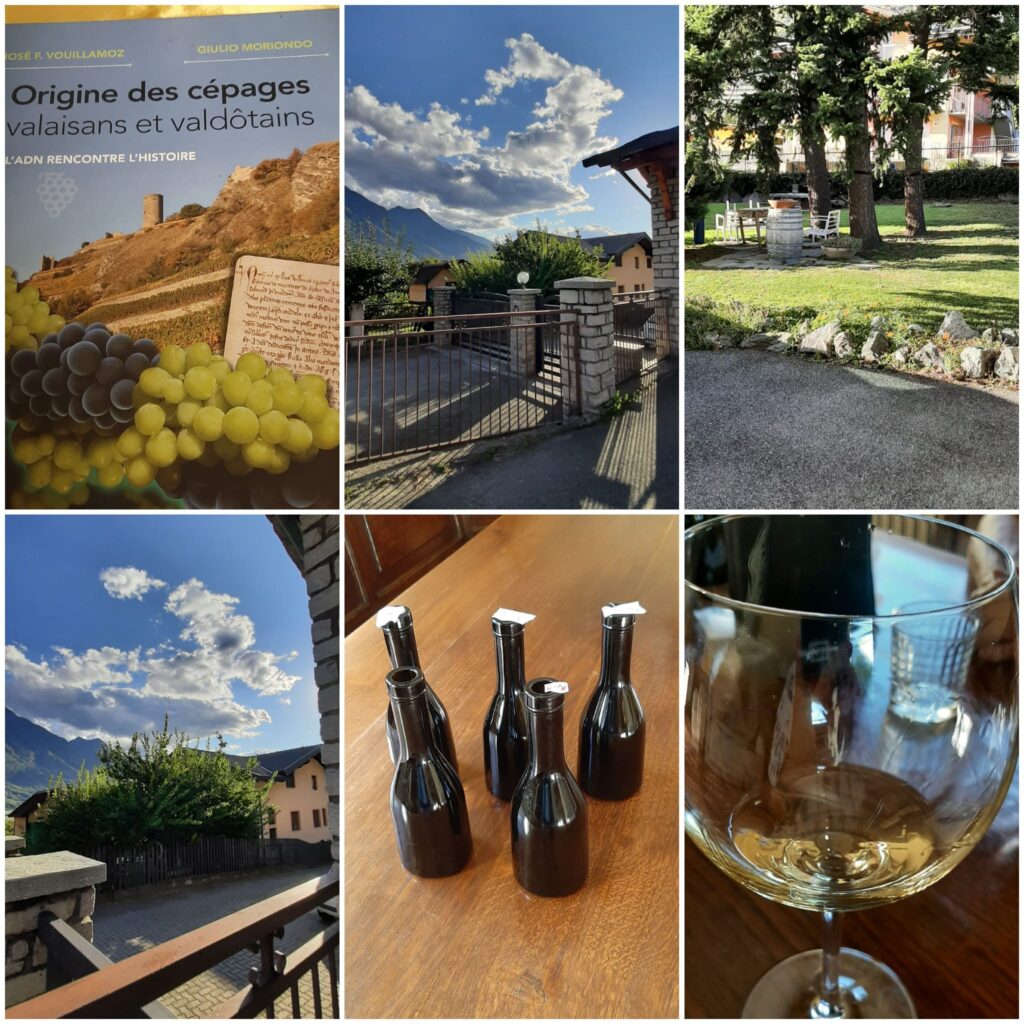The true experts don’t drink the wine. They are tasting a secrets”
( Salvador Dali )
I must to say , when I came back in my records, I seems to be lucky. Here is a new story to tell.
In reality this story initiated during my visit to the estate of Anna Santis. Anna Santis is extraordinary woman and the stunning winemaker , I keep already in mind her excellent Pinot Noir and Müller Thurgau, well kept vineyards together with a lot of vegetables attached, the garden full of colours, secret romantic places for the estate visitors .
Being in wine cellar of Anna Santis I have seen a book which captured my interest, the book of the famous specialist José Vouillamoz together with Giulio Moriondo, “Origine des cépages valaisans et valdôtains : l’ADN rencontre l’histoire”.
Anna Santis have explained me that the coauthor and the researcher Giulio Moriondo is becoming originally from the Aosta Valley, and , probably, till now lives here. But she didn’t even know the email of him. Returned to the hotel I have started immediately to research on Google, and at least, I was able to contact Giulio Moriondo.For me, the person who is passionate with autochthonous varieties, relations between varieties, progenitors and relatives of them, the analyses of DNA etc, a meeting with the professional who made for a lot of years the research and who was deeply involved in this problematic, seems to be a realised dream.
And here I am, ready for a visit.
When I have seen the small wine cellar of the famous researcher and connoisseur of autochthonous varieties from Aosta Valley, I understood what doesn’t term “ garage producers “. And it’s really this way, the wine cellar isn’t just small, better to say with dimensions micro.
Tasted wines were were very interesting, and of course, also the explanations of Giulio Moriondo. We have tasted some wines together.
The vineyards are located in the neighbourhood of cities Nus and Quart, but I haven’t an opportunity to visit them. Let’s hope the next time I will succeed.
The first tasted wine was a cuvée of Petite Arvine 30%, and Petit Rouge white grapes, the vine identified and recovered from the old plant by Giulio Moriondo 14 years ago. The bud loan mutation of genetic character responsible for colouring of grapes how have explained me the researcher kindly. The brief maceration for a day. The wine is very floral, with delicate citrus touch . The wine is fresh, fruity, sapid. The vintage 2018.
A cuvée of Petite Rouge, Fumin, Cornalin, 2019.
Olfactory offers an aroma of raspberry, small red fruits. The wine with very nice integrated tannins,soft, hot.
Equal cuvée of Petite Rouge, Fumin, Cornalin, 2018. The part of Fumin is more important, tobacco scents. I like very much this wine .
The cuvée of Nebbiolo cca 60-70%, Petite Rouge, Cornalin, 2019. Lo Rej , the Cuvée du Roi. The rebirth of an aristocratic luxury wine from Aosta Valley, Clairet. The first mention of Clairet is mentioned in the medieval chronic in 1494. The king Carlo VIII during the travel to conquest the Kingdom of Naples had been stayed at the castle of Isogne and here he had tasted it. Here is the story told to me by Giulio Moriondo while we have tasted the great wine.
( “…Clairet wasn’t as one would think the simple wine rosé, acidulous and light, originated from not very matured or damaged grapes; it was a potent wine rich story originated from dried grapes…” – Vini Excellencia”, G. Moriondo 2008 ).
The grapes of Nebbiolo have been dried in cassettes for approximately 2 or 3 months, the vinification was done with method “ rigoverno alla Toscana “ ( similar to Valpolicella ripasso) . The colour deep garnet red. The olfactory is rich and full, raspberry, blackberry, sour cherry,pepper, spices. The mouthfeel is well-balanced, with presenting and balanced tannins ,full, full body,spicy, nice persistence.
And , at the finish, phenomenal passito. Gewürztraminer 60%, Cornalin 40%.
The input of Giulio Moriondo to the knowledge of autochthonous varieties, determined the genetic relationships of grape varieties is important, interesting is also his method of wine production without clarifying agents and without any chemical compounds tended to prevent deposits , also very fine ones, to work with the simple artisan techniques of vinification.
The other rare autochthonous variety from Aosta Valley Neyret de Saint-Vincent, the variety of red grapes, an another of progenitors discovered through utilisation of DNA analysis is the Switzerland variety Rouge de Valais. The almost extinct variety is cultivated at few vineyards between Arnad and Montjovet. I am really curious to see it , if possible in future. The world of the autochthonous varieties is so fascinating!
